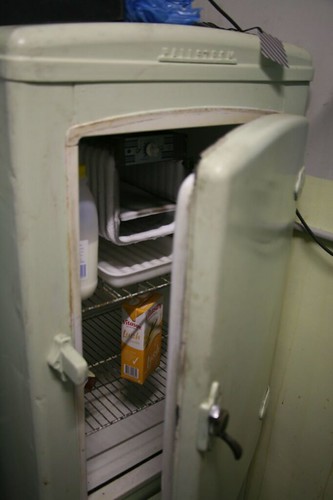By David Hunter
Chris Bertram of Crooked Timber links to this 1958 piece of research on how children behaved when locked inside fridges…
Using a specially designed enclosure, 201 children 2 to 5 years of age took part in tests in which six devices were used, including two developed in the course of this experiment as the result of observation of behavior. Success in escaping was dependent on the device, a child’s age and size and his behavior. It was also influenced by the educational level of the parents, a higher rate of success being associated with fewer years of education attained by mother and father combined. Three major types of behavior were observed: (1) inaction, with no effort or only slight effort to get out (24%); (2) purposeful effort to escape (39%); (3) violent action both directed toward escape and undirected (37%). Some of the children made no outcry (6% of the 2-year-olds and 50% of the 5-year-olds). Not all children pushed. When tested with devices where pushing was appropriate, 61% used this technique. Some children had curious twisting and twining movements of the fingers or clenching of the hands. When presented with a gadget that could be grasped, some (18%) pulled, a few (9%) pushed, but 40% tried to turn it like a doorknob. Time of confinement in the enclosure was short for most children. Three-fourths released themselves or were released in less than 3 minutes; one-fourth in less than 10 seconds. Of those who let themselves out, one-half did so in less than 10 seconds. One-third of the children emerged unruffled, about half were upset but could be comforted easily, and a small group (11%) required some help to become calm. 1.
And suggests (I suspect somewhat in jest) that a modern university research ethics committee would not approve of this research. I’m not totally convinced that at least some analogue of this study could not get through a research ethics committee.
You might ask why was the research being carried out? Well the answer is “Behavior of young children in a situation simulating entrapment in refrigerators was studied in order to develop standards for inside releasing devices, in accordance with Public Law 930 of the 84th Congress.”
This sounds absurd but we have to remember that unlike modern fridges old fridges didn’t use weak magnetic seals to close, they instead used an array of catches and handles such as this charming example:  2
2
As such they were somewhat more difficult to escape from.
There is likewise a case to be made why this research had to be done using actual children and without their knowing participation (the full paper describes how the children are separated from their parents and then lured into the fridge simulator using cartoons!). They needed to know how children would react in a “natural” situation rather than one where they were trying to perform.
As one of the commentators over at Crooked Timber notes there is a strong case to suggest that this research did indeed do some good:
Kraus (1985) reviewed the effectiveness of the Refrigerator Safety Act in California over the period 1960–1981. Suffocation deaths in refrigerators and freezers fell from about 2 per million in 1960 to less than 0.5 per million in 1981 (see figure 3 of the paper).
J F Kraus (1985). Effectiveness of measures to prevent unintentional deaths of infants and children from suffocation and strangulation. Public Health Rep. 100(2): 231–240.
This obviously has to be balanced against the psychological costs of the study to the children who participated.
So do you think this research was justified and/or what modifications would you require for it to be approved by a research ethics committee?